Strategy Project: Tesco, Organisational Analysis and Recommendations
VerifiedAdded on 2023/01/12
|11
|3885
|62
Report
AI Summary
This report is a comprehensive strategic analysis of Tesco, a leading retail company. It begins with an introduction to strategic management and its importance, followed by an overview of Tesco's organizational structure and operations. The main body of the report compares strategic theories, such as Porter's Five Forces model and PESTLE analysis, with the company's practical experiences, evaluating their impact on Tesco's strategies and performance. The analysis explores competitive rivalry, supplier and buyer power, threats of substitutes and new entrants, and external factors like political and economic influences. The report concludes with recommendations for Tesco's future strategic direction and includes a detailed list of references. This report is a valuable resource for understanding the application of strategic management principles in a real-world business context.
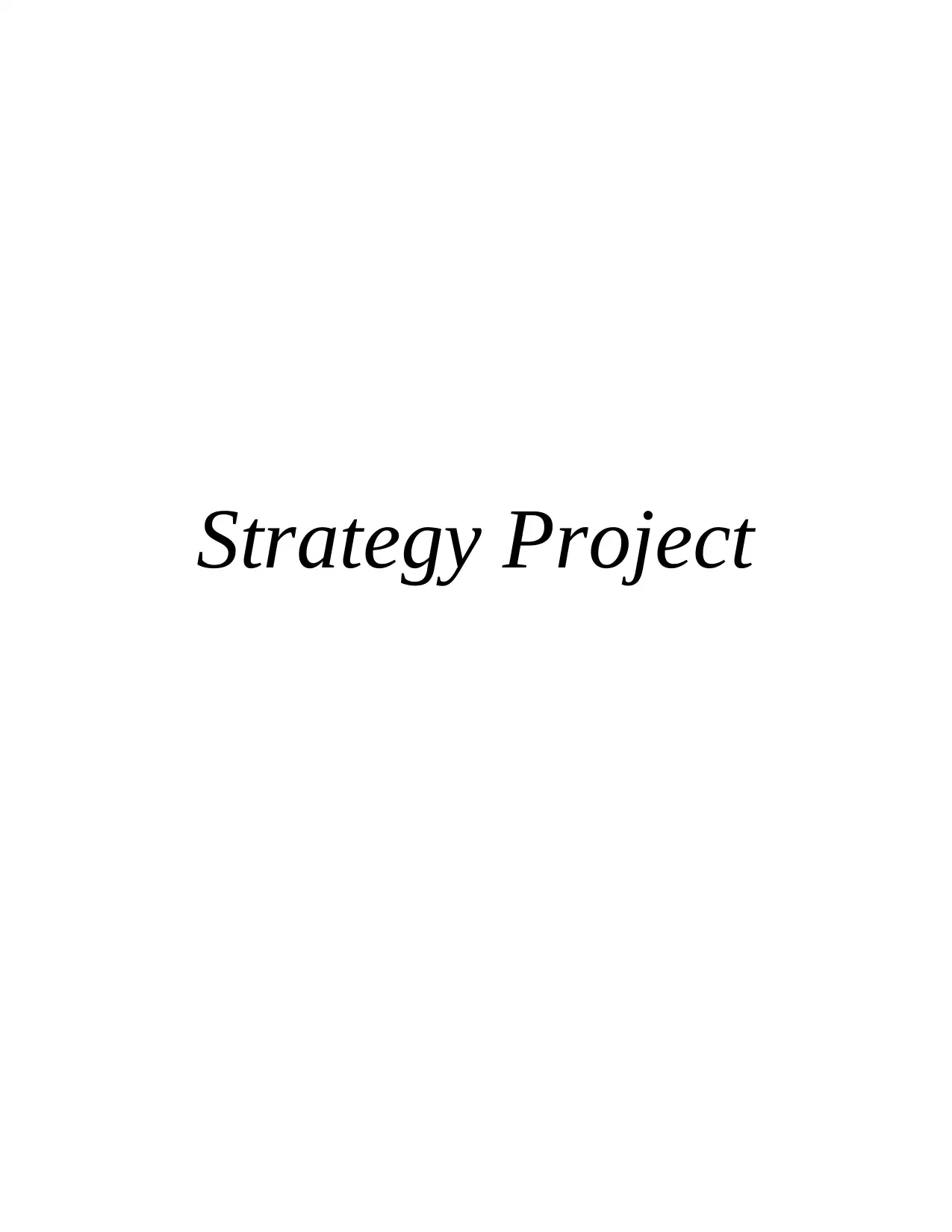
Strategy Project
Paraphrase This Document
Need a fresh take? Get an instant paraphrase of this document with our AI Paraphraser
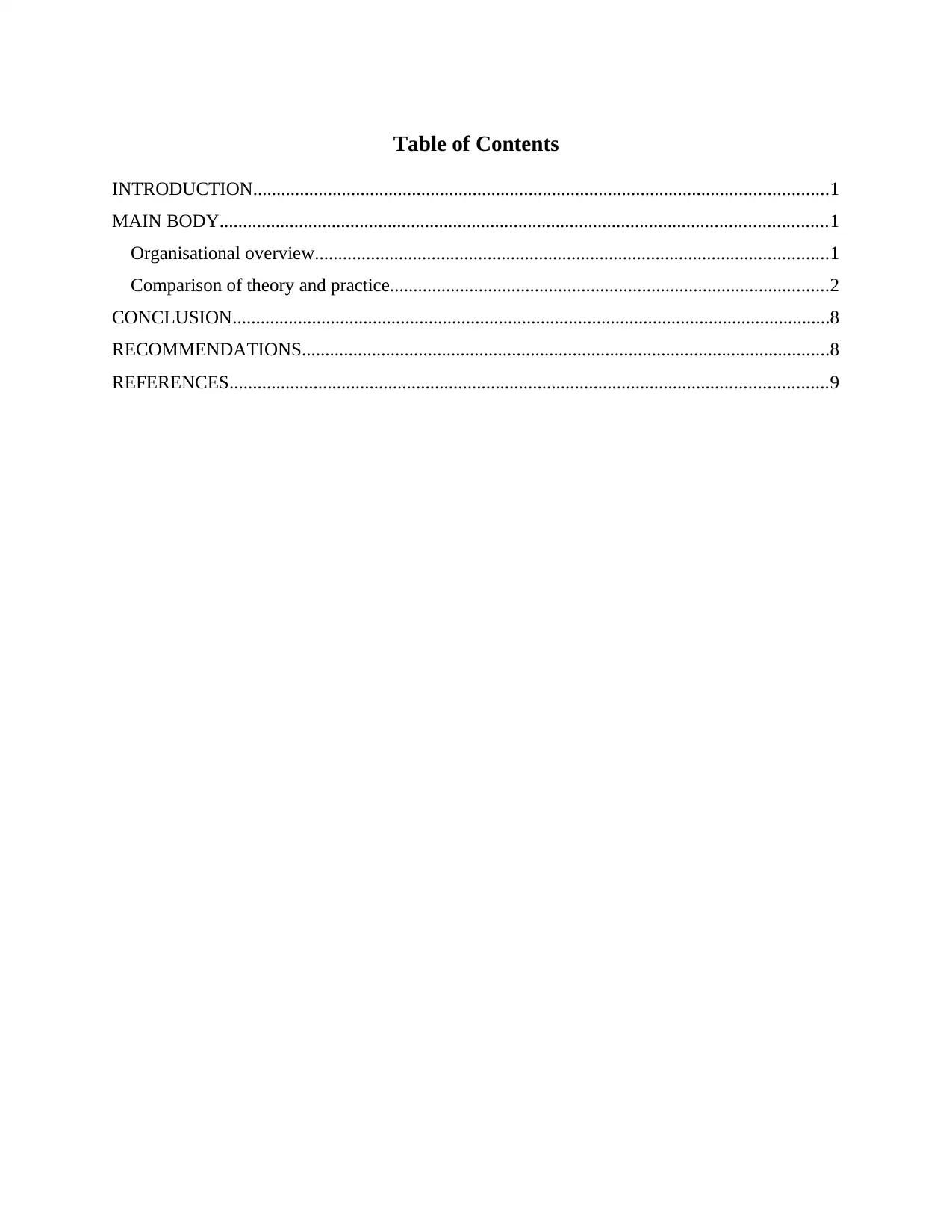
Table of Contents
INTRODUCTION...........................................................................................................................1
MAIN BODY..................................................................................................................................1
Organisational overview..............................................................................................................1
Comparison of theory and practice..............................................................................................2
CONCLUSION................................................................................................................................8
RECOMMENDATIONS.................................................................................................................8
REFERENCES................................................................................................................................9
INTRODUCTION...........................................................................................................................1
MAIN BODY..................................................................................................................................1
Organisational overview..............................................................................................................1
Comparison of theory and practice..............................................................................................2
CONCLUSION................................................................................................................................8
RECOMMENDATIONS.................................................................................................................8
REFERENCES................................................................................................................................9
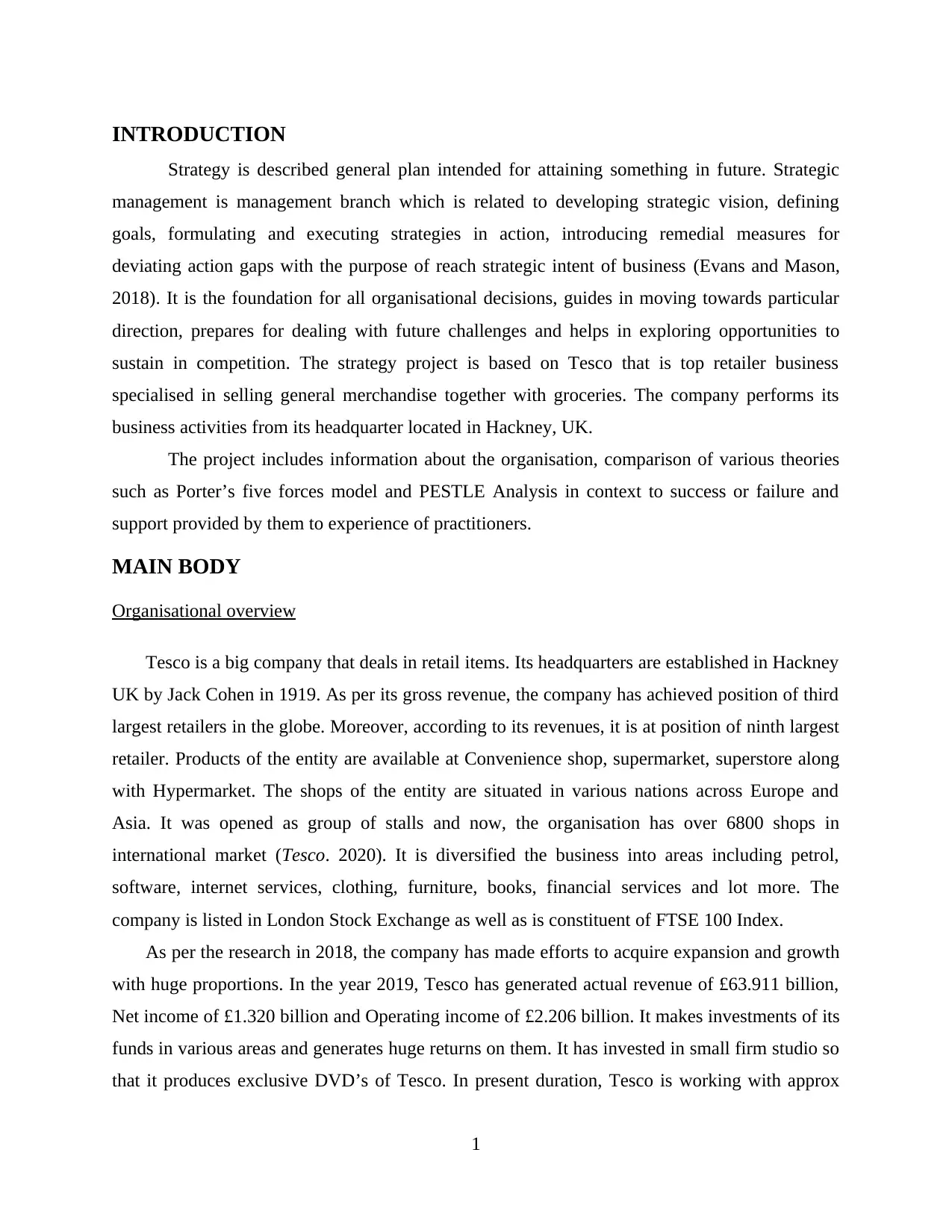
INTRODUCTION
Strategy is described general plan intended for attaining something in future. Strategic
management is management branch which is related to developing strategic vision, defining
goals, formulating and executing strategies in action, introducing remedial measures for
deviating action gaps with the purpose of reach strategic intent of business (Evans and Mason,
2018). It is the foundation for all organisational decisions, guides in moving towards particular
direction, prepares for dealing with future challenges and helps in exploring opportunities to
sustain in competition. The strategy project is based on Tesco that is top retailer business
specialised in selling general merchandise together with groceries. The company performs its
business activities from its headquarter located in Hackney, UK.
The project includes information about the organisation, comparison of various theories
such as Porter’s five forces model and PESTLE Analysis in context to success or failure and
support provided by them to experience of practitioners.
MAIN BODY
Organisational overview
Tesco is a big company that deals in retail items. Its headquarters are established in Hackney
UK by Jack Cohen in 1919. As per its gross revenue, the company has achieved position of third
largest retailers in the globe. Moreover, according to its revenues, it is at position of ninth largest
retailer. Products of the entity are available at Convenience shop, supermarket, superstore along
with Hypermarket. The shops of the entity are situated in various nations across Europe and
Asia. It was opened as group of stalls and now, the organisation has over 6800 shops in
international market (Tesco. 2020). It is diversified the business into areas including petrol,
software, internet services, clothing, furniture, books, financial services and lot more. The
company is listed in London Stock Exchange as well as is constituent of FTSE 100 Index.
As per the research in 2018, the company has made efforts to acquire expansion and growth
with huge proportions. In the year 2019, Tesco has generated actual revenue of £63.911 billion,
Net income of £1.320 billion and Operating income of £2.206 billion. It makes investments of its
funds in various areas and generates huge returns on them. It has invested in small firm studio so
that it produces exclusive DVD’s of Tesco. In present duration, Tesco is working with approx
1
Strategy is described general plan intended for attaining something in future. Strategic
management is management branch which is related to developing strategic vision, defining
goals, formulating and executing strategies in action, introducing remedial measures for
deviating action gaps with the purpose of reach strategic intent of business (Evans and Mason,
2018). It is the foundation for all organisational decisions, guides in moving towards particular
direction, prepares for dealing with future challenges and helps in exploring opportunities to
sustain in competition. The strategy project is based on Tesco that is top retailer business
specialised in selling general merchandise together with groceries. The company performs its
business activities from its headquarter located in Hackney, UK.
The project includes information about the organisation, comparison of various theories
such as Porter’s five forces model and PESTLE Analysis in context to success or failure and
support provided by them to experience of practitioners.
MAIN BODY
Organisational overview
Tesco is a big company that deals in retail items. Its headquarters are established in Hackney
UK by Jack Cohen in 1919. As per its gross revenue, the company has achieved position of third
largest retailers in the globe. Moreover, according to its revenues, it is at position of ninth largest
retailer. Products of the entity are available at Convenience shop, supermarket, superstore along
with Hypermarket. The shops of the entity are situated in various nations across Europe and
Asia. It was opened as group of stalls and now, the organisation has over 6800 shops in
international market (Tesco. 2020). It is diversified the business into areas including petrol,
software, internet services, clothing, furniture, books, financial services and lot more. The
company is listed in London Stock Exchange as well as is constituent of FTSE 100 Index.
As per the research in 2018, the company has made efforts to acquire expansion and growth
with huge proportions. In the year 2019, Tesco has generated actual revenue of £63.911 billion,
Net income of £1.320 billion and Operating income of £2.206 billion. It makes investments of its
funds in various areas and generates huge returns on them. It has invested in small firm studio so
that it produces exclusive DVD’s of Tesco. In present duration, Tesco is working with approx
1
⊘ This is a preview!⊘
Do you want full access?
Subscribe today to unlock all pages.

Trusted by 1+ million students worldwide
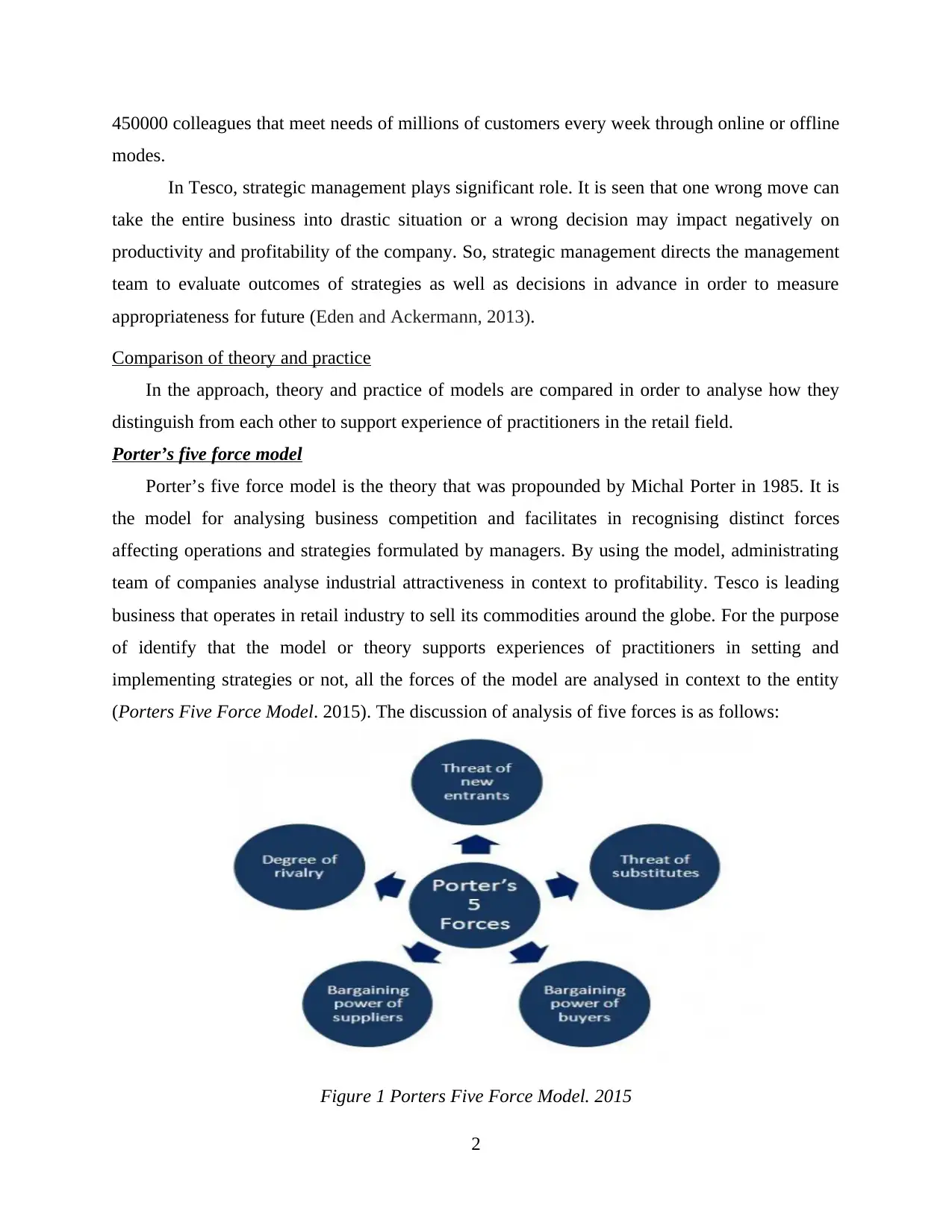
450000 colleagues that meet needs of millions of customers every week through online or offline
modes.
In Tesco, strategic management plays significant role. It is seen that one wrong move can
take the entire business into drastic situation or a wrong decision may impact negatively on
productivity and profitability of the company. So, strategic management directs the management
team to evaluate outcomes of strategies as well as decisions in advance in order to measure
appropriateness for future (Eden and Ackermann, 2013).
Comparison of theory and practice
In the approach, theory and practice of models are compared in order to analyse how they
distinguish from each other to support experience of practitioners in the retail field.
Porter’s five force model
Porter’s five force model is the theory that was propounded by Michal Porter in 1985. It is
the model for analysing business competition and facilitates in recognising distinct forces
affecting operations and strategies formulated by managers. By using the model, administrating
team of companies analyse industrial attractiveness in context to profitability. Tesco is leading
business that operates in retail industry to sell its commodities around the globe. For the purpose
of identify that the model or theory supports experiences of practitioners in setting and
implementing strategies or not, all the forces of the model are analysed in context to the entity
(Porters Five Force Model. 2015). The discussion of analysis of five forces is as follows:
Figure 1 Porters Five Force Model. 2015
2
modes.
In Tesco, strategic management plays significant role. It is seen that one wrong move can
take the entire business into drastic situation or a wrong decision may impact negatively on
productivity and profitability of the company. So, strategic management directs the management
team to evaluate outcomes of strategies as well as decisions in advance in order to measure
appropriateness for future (Eden and Ackermann, 2013).
Comparison of theory and practice
In the approach, theory and practice of models are compared in order to analyse how they
distinguish from each other to support experience of practitioners in the retail field.
Porter’s five force model
Porter’s five force model is the theory that was propounded by Michal Porter in 1985. It is
the model for analysing business competition and facilitates in recognising distinct forces
affecting operations and strategies formulated by managers. By using the model, administrating
team of companies analyse industrial attractiveness in context to profitability. Tesco is leading
business that operates in retail industry to sell its commodities around the globe. For the purpose
of identify that the model or theory supports experiences of practitioners in setting and
implementing strategies or not, all the forces of the model are analysed in context to the entity
(Porters Five Force Model. 2015). The discussion of analysis of five forces is as follows:
Figure 1 Porters Five Force Model. 2015
2
Paraphrase This Document
Need a fresh take? Get an instant paraphrase of this document with our AI Paraphraser
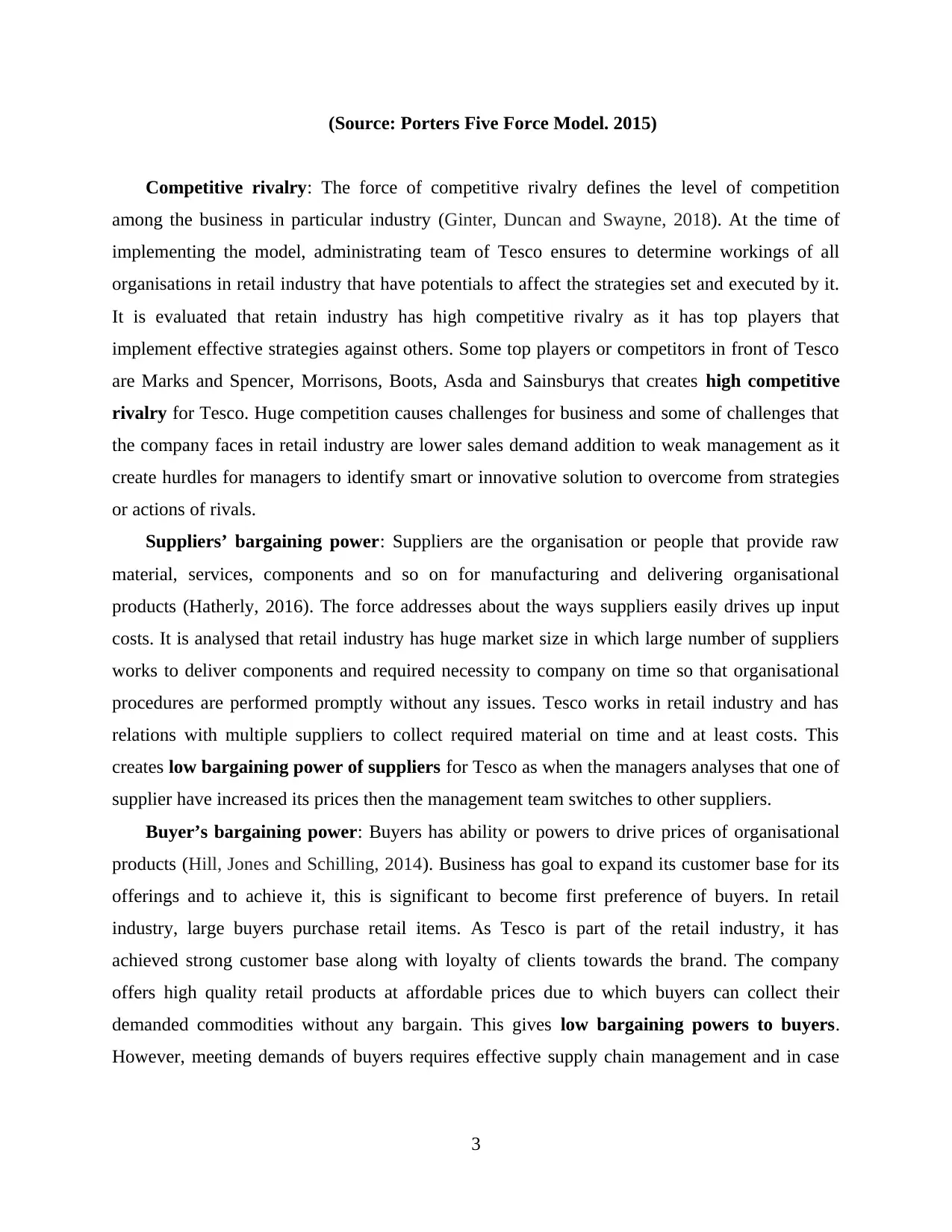
(Source: Porters Five Force Model. 2015)
Competitive rivalry: The force of competitive rivalry defines the level of competition
among the business in particular industry (Ginter, Duncan and Swayne, 2018). At the time of
implementing the model, administrating team of Tesco ensures to determine workings of all
organisations in retail industry that have potentials to affect the strategies set and executed by it.
It is evaluated that retain industry has high competitive rivalry as it has top players that
implement effective strategies against others. Some top players or competitors in front of Tesco
are Marks and Spencer, Morrisons, Boots, Asda and Sainsburys that creates high competitive
rivalry for Tesco. Huge competition causes challenges for business and some of challenges that
the company faces in retail industry are lower sales demand addition to weak management as it
create hurdles for managers to identify smart or innovative solution to overcome from strategies
or actions of rivals.
Suppliers’ bargaining power: Suppliers are the organisation or people that provide raw
material, services, components and so on for manufacturing and delivering organisational
products (Hatherly, 2016). The force addresses about the ways suppliers easily drives up input
costs. It is analysed that retail industry has huge market size in which large number of suppliers
works to deliver components and required necessity to company on time so that organisational
procedures are performed promptly without any issues. Tesco works in retail industry and has
relations with multiple suppliers to collect required material on time and at least costs. This
creates low bargaining power of suppliers for Tesco as when the managers analyses that one of
supplier have increased its prices then the management team switches to other suppliers.
Buyer’s bargaining power: Buyers has ability or powers to drive prices of organisational
products (Hill, Jones and Schilling, 2014). Business has goal to expand its customer base for its
offerings and to achieve it, this is significant to become first preference of buyers. In retail
industry, large buyers purchase retail items. As Tesco is part of the retail industry, it has
achieved strong customer base along with loyalty of clients towards the brand. The company
offers high quality retail products at affordable prices due to which buyers can collect their
demanded commodities without any bargain. This gives low bargaining powers to buyers.
However, meeting demands of buyers requires effective supply chain management and in case
3
Competitive rivalry: The force of competitive rivalry defines the level of competition
among the business in particular industry (Ginter, Duncan and Swayne, 2018). At the time of
implementing the model, administrating team of Tesco ensures to determine workings of all
organisations in retail industry that have potentials to affect the strategies set and executed by it.
It is evaluated that retain industry has high competitive rivalry as it has top players that
implement effective strategies against others. Some top players or competitors in front of Tesco
are Marks and Spencer, Morrisons, Boots, Asda and Sainsburys that creates high competitive
rivalry for Tesco. Huge competition causes challenges for business and some of challenges that
the company faces in retail industry are lower sales demand addition to weak management as it
create hurdles for managers to identify smart or innovative solution to overcome from strategies
or actions of rivals.
Suppliers’ bargaining power: Suppliers are the organisation or people that provide raw
material, services, components and so on for manufacturing and delivering organisational
products (Hatherly, 2016). The force addresses about the ways suppliers easily drives up input
costs. It is analysed that retail industry has huge market size in which large number of suppliers
works to deliver components and required necessity to company on time so that organisational
procedures are performed promptly without any issues. Tesco works in retail industry and has
relations with multiple suppliers to collect required material on time and at least costs. This
creates low bargaining power of suppliers for Tesco as when the managers analyses that one of
supplier have increased its prices then the management team switches to other suppliers.
Buyer’s bargaining power: Buyers has ability or powers to drive prices of organisational
products (Hill, Jones and Schilling, 2014). Business has goal to expand its customer base for its
offerings and to achieve it, this is significant to become first preference of buyers. In retail
industry, large buyers purchase retail items. As Tesco is part of the retail industry, it has
achieved strong customer base along with loyalty of clients towards the brand. The company
offers high quality retail products at affordable prices due to which buyers can collect their
demanded commodities without any bargain. This gives low bargaining powers to buyers.
However, meeting demands of buyers requires effective supply chain management and in case
3
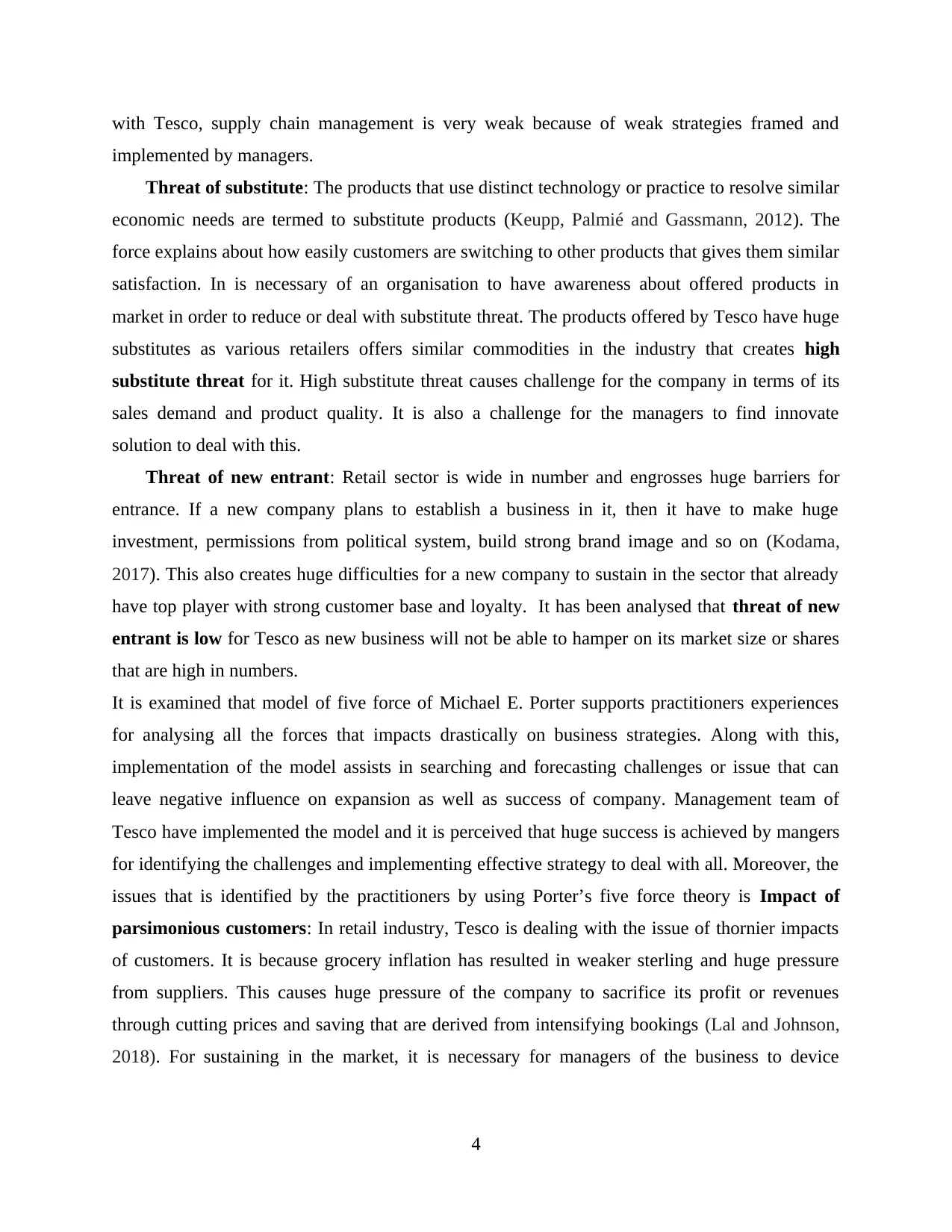
with Tesco, supply chain management is very weak because of weak strategies framed and
implemented by managers.
Threat of substitute: The products that use distinct technology or practice to resolve similar
economic needs are termed to substitute products (Keupp, Palmié and Gassmann, 2012). The
force explains about how easily customers are switching to other products that gives them similar
satisfaction. In is necessary of an organisation to have awareness about offered products in
market in order to reduce or deal with substitute threat. The products offered by Tesco have huge
substitutes as various retailers offers similar commodities in the industry that creates high
substitute threat for it. High substitute threat causes challenge for the company in terms of its
sales demand and product quality. It is also a challenge for the managers to find innovate
solution to deal with this.
Threat of new entrant: Retail sector is wide in number and engrosses huge barriers for
entrance. If a new company plans to establish a business in it, then it have to make huge
investment, permissions from political system, build strong brand image and so on (Kodama,
2017). This also creates huge difficulties for a new company to sustain in the sector that already
have top player with strong customer base and loyalty. It has been analysed that threat of new
entrant is low for Tesco as new business will not be able to hamper on its market size or shares
that are high in numbers.
It is examined that model of five force of Michael E. Porter supports practitioners experiences
for analysing all the forces that impacts drastically on business strategies. Along with this,
implementation of the model assists in searching and forecasting challenges or issue that can
leave negative influence on expansion as well as success of company. Management team of
Tesco have implemented the model and it is perceived that huge success is achieved by mangers
for identifying the challenges and implementing effective strategy to deal with all. Moreover, the
issues that is identified by the practitioners by using Porter’s five force theory is Impact of
parsimonious customers: In retail industry, Tesco is dealing with the issue of thornier impacts
of customers. It is because grocery inflation has resulted in weaker sterling and huge pressure
from suppliers. This causes huge pressure of the company to sacrifice its profit or revenues
through cutting prices and saving that are derived from intensifying bookings (Lal and Johnson,
2018). For sustaining in the market, it is necessary for managers of the business to device
4
implemented by managers.
Threat of substitute: The products that use distinct technology or practice to resolve similar
economic needs are termed to substitute products (Keupp, Palmié and Gassmann, 2012). The
force explains about how easily customers are switching to other products that gives them similar
satisfaction. In is necessary of an organisation to have awareness about offered products in
market in order to reduce or deal with substitute threat. The products offered by Tesco have huge
substitutes as various retailers offers similar commodities in the industry that creates high
substitute threat for it. High substitute threat causes challenge for the company in terms of its
sales demand and product quality. It is also a challenge for the managers to find innovate
solution to deal with this.
Threat of new entrant: Retail sector is wide in number and engrosses huge barriers for
entrance. If a new company plans to establish a business in it, then it have to make huge
investment, permissions from political system, build strong brand image and so on (Kodama,
2017). This also creates huge difficulties for a new company to sustain in the sector that already
have top player with strong customer base and loyalty. It has been analysed that threat of new
entrant is low for Tesco as new business will not be able to hamper on its market size or shares
that are high in numbers.
It is examined that model of five force of Michael E. Porter supports practitioners experiences
for analysing all the forces that impacts drastically on business strategies. Along with this,
implementation of the model assists in searching and forecasting challenges or issue that can
leave negative influence on expansion as well as success of company. Management team of
Tesco have implemented the model and it is perceived that huge success is achieved by mangers
for identifying the challenges and implementing effective strategy to deal with all. Moreover, the
issues that is identified by the practitioners by using Porter’s five force theory is Impact of
parsimonious customers: In retail industry, Tesco is dealing with the issue of thornier impacts
of customers. It is because grocery inflation has resulted in weaker sterling and huge pressure
from suppliers. This causes huge pressure of the company to sacrifice its profit or revenues
through cutting prices and saving that are derived from intensifying bookings (Lal and Johnson,
2018). For sustaining in the market, it is necessary for managers of the business to device
4
⊘ This is a preview!⊘
Do you want full access?
Subscribe today to unlock all pages.

Trusted by 1+ million students worldwide
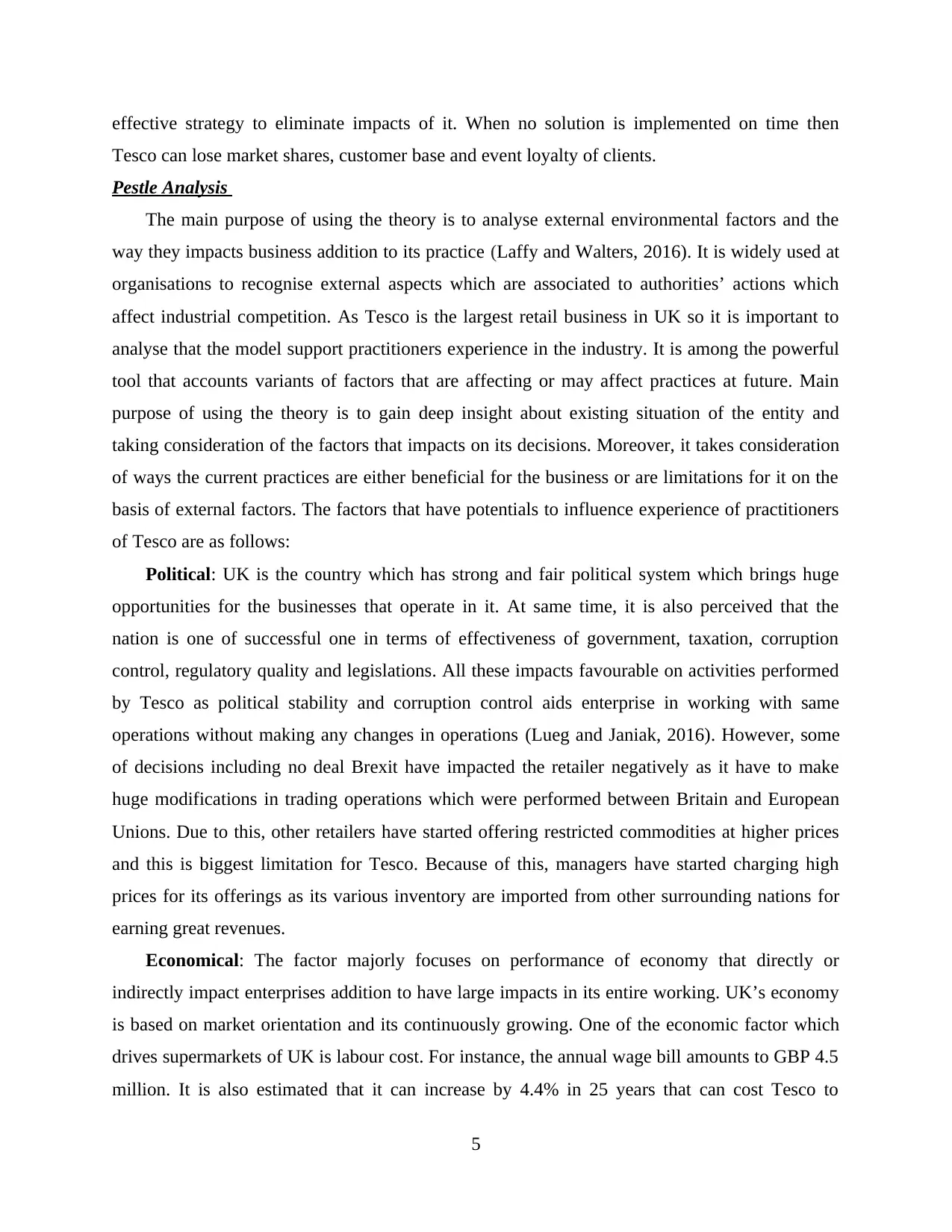
effective strategy to eliminate impacts of it. When no solution is implemented on time then
Tesco can lose market shares, customer base and event loyalty of clients.
Pestle Analysis
The main purpose of using the theory is to analyse external environmental factors and the
way they impacts business addition to its practice (Laffy and Walters, 2016). It is widely used at
organisations to recognise external aspects which are associated to authorities’ actions which
affect industrial competition. As Tesco is the largest retail business in UK so it is important to
analyse that the model support practitioners experience in the industry. It is among the powerful
tool that accounts variants of factors that are affecting or may affect practices at future. Main
purpose of using the theory is to gain deep insight about existing situation of the entity and
taking consideration of the factors that impacts on its decisions. Moreover, it takes consideration
of ways the current practices are either beneficial for the business or are limitations for it on the
basis of external factors. The factors that have potentials to influence experience of practitioners
of Tesco are as follows:
Political: UK is the country which has strong and fair political system which brings huge
opportunities for the businesses that operate in it. At same time, it is also perceived that the
nation is one of successful one in terms of effectiveness of government, taxation, corruption
control, regulatory quality and legislations. All these impacts favourable on activities performed
by Tesco as political stability and corruption control aids enterprise in working with same
operations without making any changes in operations (Lueg and Janiak, 2016). However, some
of decisions including no deal Brexit have impacted the retailer negatively as it have to make
huge modifications in trading operations which were performed between Britain and European
Unions. Due to this, other retailers have started offering restricted commodities at higher prices
and this is biggest limitation for Tesco. Because of this, managers have started charging high
prices for its offerings as its various inventory are imported from other surrounding nations for
earning great revenues.
Economical: The factor majorly focuses on performance of economy that directly or
indirectly impact enterprises addition to have large impacts in its entire working. UK’s economy
is based on market orientation and its continuously growing. One of the economic factor which
drives supermarkets of UK is labour cost. For instance, the annual wage bill amounts to GBP 4.5
million. It is also estimated that it can increase by 4.4% in 25 years that can cost Tesco to
5
Tesco can lose market shares, customer base and event loyalty of clients.
Pestle Analysis
The main purpose of using the theory is to analyse external environmental factors and the
way they impacts business addition to its practice (Laffy and Walters, 2016). It is widely used at
organisations to recognise external aspects which are associated to authorities’ actions which
affect industrial competition. As Tesco is the largest retail business in UK so it is important to
analyse that the model support practitioners experience in the industry. It is among the powerful
tool that accounts variants of factors that are affecting or may affect practices at future. Main
purpose of using the theory is to gain deep insight about existing situation of the entity and
taking consideration of the factors that impacts on its decisions. Moreover, it takes consideration
of ways the current practices are either beneficial for the business or are limitations for it on the
basis of external factors. The factors that have potentials to influence experience of practitioners
of Tesco are as follows:
Political: UK is the country which has strong and fair political system which brings huge
opportunities for the businesses that operate in it. At same time, it is also perceived that the
nation is one of successful one in terms of effectiveness of government, taxation, corruption
control, regulatory quality and legislations. All these impacts favourable on activities performed
by Tesco as political stability and corruption control aids enterprise in working with same
operations without making any changes in operations (Lueg and Janiak, 2016). However, some
of decisions including no deal Brexit have impacted the retailer negatively as it have to make
huge modifications in trading operations which were performed between Britain and European
Unions. Due to this, other retailers have started offering restricted commodities at higher prices
and this is biggest limitation for Tesco. Because of this, managers have started charging high
prices for its offerings as its various inventory are imported from other surrounding nations for
earning great revenues.
Economical: The factor majorly focuses on performance of economy that directly or
indirectly impact enterprises addition to have large impacts in its entire working. UK’s economy
is based on market orientation and its continuously growing. One of the economic factor which
drives supermarkets of UK is labour cost. For instance, the annual wage bill amounts to GBP 4.5
million. It is also estimated that it can increase by 4.4% in 25 years that can cost Tesco to
5
Paraphrase This Document
Need a fresh take? Get an instant paraphrase of this document with our AI Paraphraser
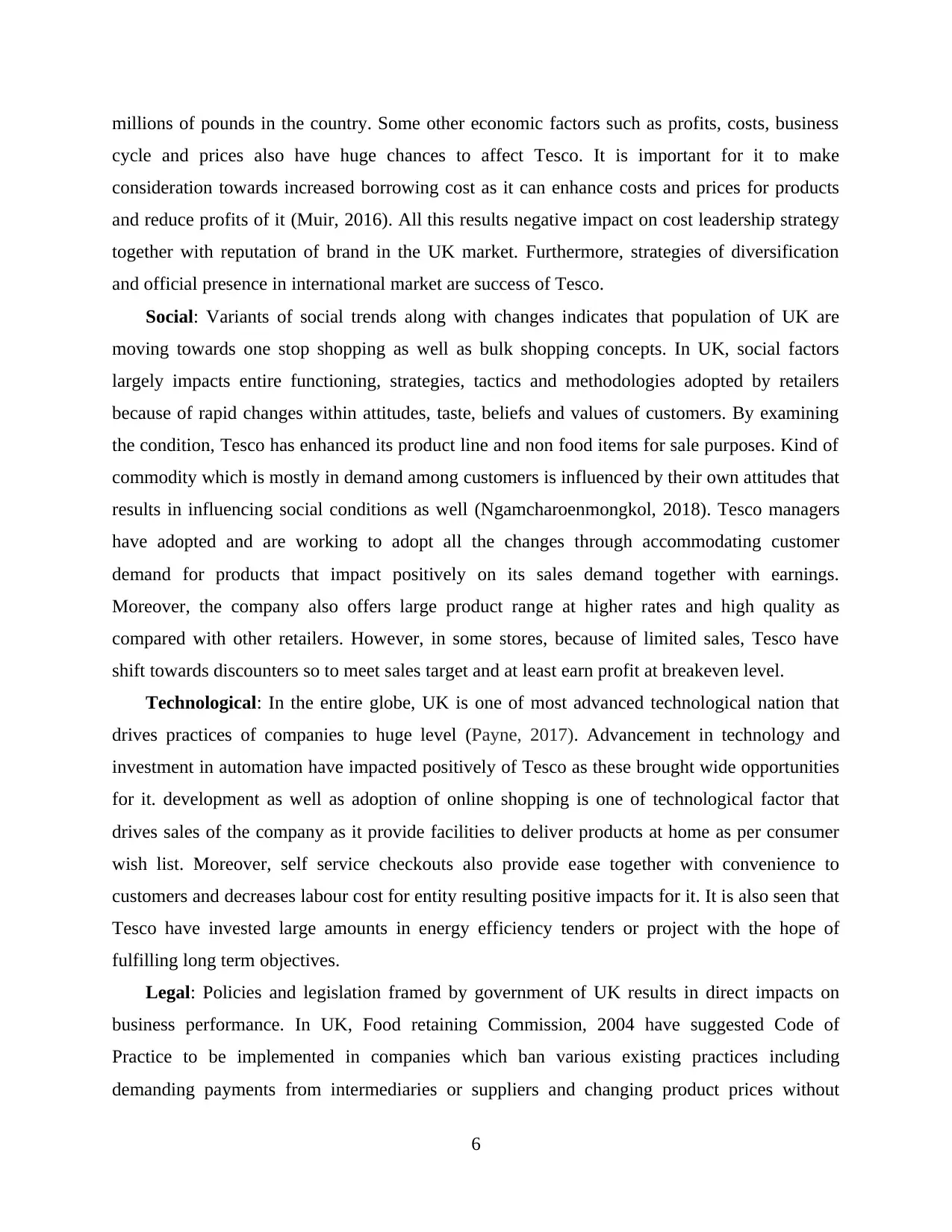
millions of pounds in the country. Some other economic factors such as profits, costs, business
cycle and prices also have huge chances to affect Tesco. It is important for it to make
consideration towards increased borrowing cost as it can enhance costs and prices for products
and reduce profits of it (Muir, 2016). All this results negative impact on cost leadership strategy
together with reputation of brand in the UK market. Furthermore, strategies of diversification
and official presence in international market are success of Tesco.
Social: Variants of social trends along with changes indicates that population of UK are
moving towards one stop shopping as well as bulk shopping concepts. In UK, social factors
largely impacts entire functioning, strategies, tactics and methodologies adopted by retailers
because of rapid changes within attitudes, taste, beliefs and values of customers. By examining
the condition, Tesco has enhanced its product line and non food items for sale purposes. Kind of
commodity which is mostly in demand among customers is influenced by their own attitudes that
results in influencing social conditions as well (Ngamcharoenmongkol, 2018). Tesco managers
have adopted and are working to adopt all the changes through accommodating customer
demand for products that impact positively on its sales demand together with earnings.
Moreover, the company also offers large product range at higher rates and high quality as
compared with other retailers. However, in some stores, because of limited sales, Tesco have
shift towards discounters so to meet sales target and at least earn profit at breakeven level.
Technological: In the entire globe, UK is one of most advanced technological nation that
drives practices of companies to huge level (Payne, 2017). Advancement in technology and
investment in automation have impacted positively of Tesco as these brought wide opportunities
for it. development as well as adoption of online shopping is one of technological factor that
drives sales of the company as it provide facilities to deliver products at home as per consumer
wish list. Moreover, self service checkouts also provide ease together with convenience to
customers and decreases labour cost for entity resulting positive impacts for it. It is also seen that
Tesco have invested large amounts in energy efficiency tenders or project with the hope of
fulfilling long term objectives.
Legal: Policies and legislation framed by government of UK results in direct impacts on
business performance. In UK, Food retaining Commission, 2004 have suggested Code of
Practice to be implemented in companies which ban various existing practices including
demanding payments from intermediaries or suppliers and changing product prices without
6
cycle and prices also have huge chances to affect Tesco. It is important for it to make
consideration towards increased borrowing cost as it can enhance costs and prices for products
and reduce profits of it (Muir, 2016). All this results negative impact on cost leadership strategy
together with reputation of brand in the UK market. Furthermore, strategies of diversification
and official presence in international market are success of Tesco.
Social: Variants of social trends along with changes indicates that population of UK are
moving towards one stop shopping as well as bulk shopping concepts. In UK, social factors
largely impacts entire functioning, strategies, tactics and methodologies adopted by retailers
because of rapid changes within attitudes, taste, beliefs and values of customers. By examining
the condition, Tesco has enhanced its product line and non food items for sale purposes. Kind of
commodity which is mostly in demand among customers is influenced by their own attitudes that
results in influencing social conditions as well (Ngamcharoenmongkol, 2018). Tesco managers
have adopted and are working to adopt all the changes through accommodating customer
demand for products that impact positively on its sales demand together with earnings.
Moreover, the company also offers large product range at higher rates and high quality as
compared with other retailers. However, in some stores, because of limited sales, Tesco have
shift towards discounters so to meet sales target and at least earn profit at breakeven level.
Technological: In the entire globe, UK is one of most advanced technological nation that
drives practices of companies to huge level (Payne, 2017). Advancement in technology and
investment in automation have impacted positively of Tesco as these brought wide opportunities
for it. development as well as adoption of online shopping is one of technological factor that
drives sales of the company as it provide facilities to deliver products at home as per consumer
wish list. Moreover, self service checkouts also provide ease together with convenience to
customers and decreases labour cost for entity resulting positive impacts for it. It is also seen that
Tesco have invested large amounts in energy efficiency tenders or project with the hope of
fulfilling long term objectives.
Legal: Policies and legislation framed by government of UK results in direct impacts on
business performance. In UK, Food retaining Commission, 2004 have suggested Code of
Practice to be implemented in companies which ban various existing practices including
demanding payments from intermediaries or suppliers and changing product prices without
6
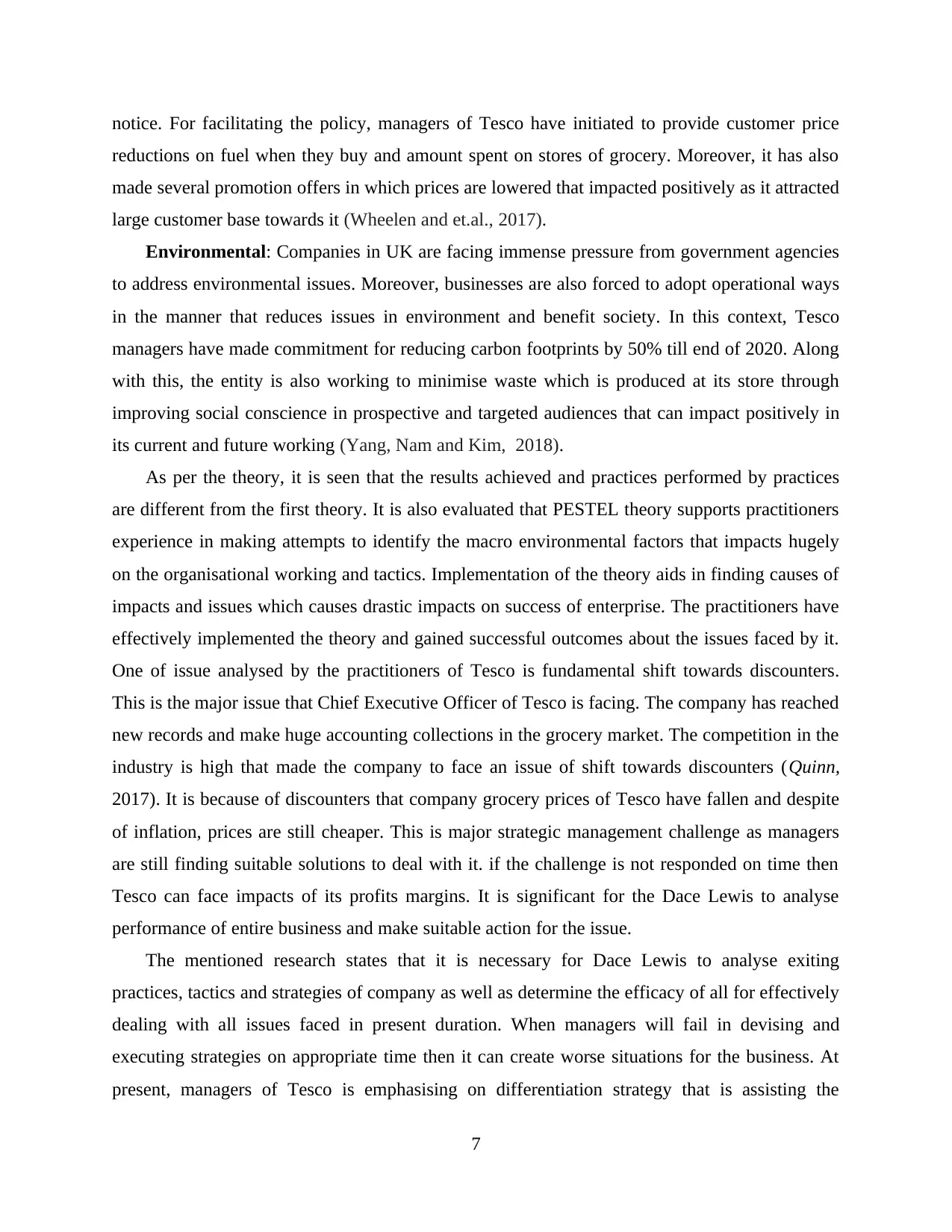
notice. For facilitating the policy, managers of Tesco have initiated to provide customer price
reductions on fuel when they buy and amount spent on stores of grocery. Moreover, it has also
made several promotion offers in which prices are lowered that impacted positively as it attracted
large customer base towards it (Wheelen and et.al., 2017).
Environmental: Companies in UK are facing immense pressure from government agencies
to address environmental issues. Moreover, businesses are also forced to adopt operational ways
in the manner that reduces issues in environment and benefit society. In this context, Tesco
managers have made commitment for reducing carbon footprints by 50% till end of 2020. Along
with this, the entity is also working to minimise waste which is produced at its store through
improving social conscience in prospective and targeted audiences that can impact positively in
its current and future working (Yang, Nam and Kim, 2018).
As per the theory, it is seen that the results achieved and practices performed by practices
are different from the first theory. It is also evaluated that PESTEL theory supports practitioners
experience in making attempts to identify the macro environmental factors that impacts hugely
on the organisational working and tactics. Implementation of the theory aids in finding causes of
impacts and issues which causes drastic impacts on success of enterprise. The practitioners have
effectively implemented the theory and gained successful outcomes about the issues faced by it.
One of issue analysed by the practitioners of Tesco is fundamental shift towards discounters.
This is the major issue that Chief Executive Officer of Tesco is facing. The company has reached
new records and make huge accounting collections in the grocery market. The competition in the
industry is high that made the company to face an issue of shift towards discounters (Quinn,
2017). It is because of discounters that company grocery prices of Tesco have fallen and despite
of inflation, prices are still cheaper. This is major strategic management challenge as managers
are still finding suitable solutions to deal with it. if the challenge is not responded on time then
Tesco can face impacts of its profits margins. It is significant for the Dace Lewis to analyse
performance of entire business and make suitable action for the issue.
The mentioned research states that it is necessary for Dace Lewis to analyse exiting
practices, tactics and strategies of company as well as determine the efficacy of all for effectively
dealing with all issues faced in present duration. When managers will fail in devising and
executing strategies on appropriate time then it can create worse situations for the business. At
present, managers of Tesco is emphasising on differentiation strategy that is assisting the
7
reductions on fuel when they buy and amount spent on stores of grocery. Moreover, it has also
made several promotion offers in which prices are lowered that impacted positively as it attracted
large customer base towards it (Wheelen and et.al., 2017).
Environmental: Companies in UK are facing immense pressure from government agencies
to address environmental issues. Moreover, businesses are also forced to adopt operational ways
in the manner that reduces issues in environment and benefit society. In this context, Tesco
managers have made commitment for reducing carbon footprints by 50% till end of 2020. Along
with this, the entity is also working to minimise waste which is produced at its store through
improving social conscience in prospective and targeted audiences that can impact positively in
its current and future working (Yang, Nam and Kim, 2018).
As per the theory, it is seen that the results achieved and practices performed by practices
are different from the first theory. It is also evaluated that PESTEL theory supports practitioners
experience in making attempts to identify the macro environmental factors that impacts hugely
on the organisational working and tactics. Implementation of the theory aids in finding causes of
impacts and issues which causes drastic impacts on success of enterprise. The practitioners have
effectively implemented the theory and gained successful outcomes about the issues faced by it.
One of issue analysed by the practitioners of Tesco is fundamental shift towards discounters.
This is the major issue that Chief Executive Officer of Tesco is facing. The company has reached
new records and make huge accounting collections in the grocery market. The competition in the
industry is high that made the company to face an issue of shift towards discounters (Quinn,
2017). It is because of discounters that company grocery prices of Tesco have fallen and despite
of inflation, prices are still cheaper. This is major strategic management challenge as managers
are still finding suitable solutions to deal with it. if the challenge is not responded on time then
Tesco can face impacts of its profits margins. It is significant for the Dace Lewis to analyse
performance of entire business and make suitable action for the issue.
The mentioned research states that it is necessary for Dace Lewis to analyse exiting
practices, tactics and strategies of company as well as determine the efficacy of all for effectively
dealing with all issues faced in present duration. When managers will fail in devising and
executing strategies on appropriate time then it can create worse situations for the business. At
present, managers of Tesco is emphasising on differentiation strategy that is assisting the
7
⊘ This is a preview!⊘
Do you want full access?
Subscribe today to unlock all pages.

Trusted by 1+ million students worldwide
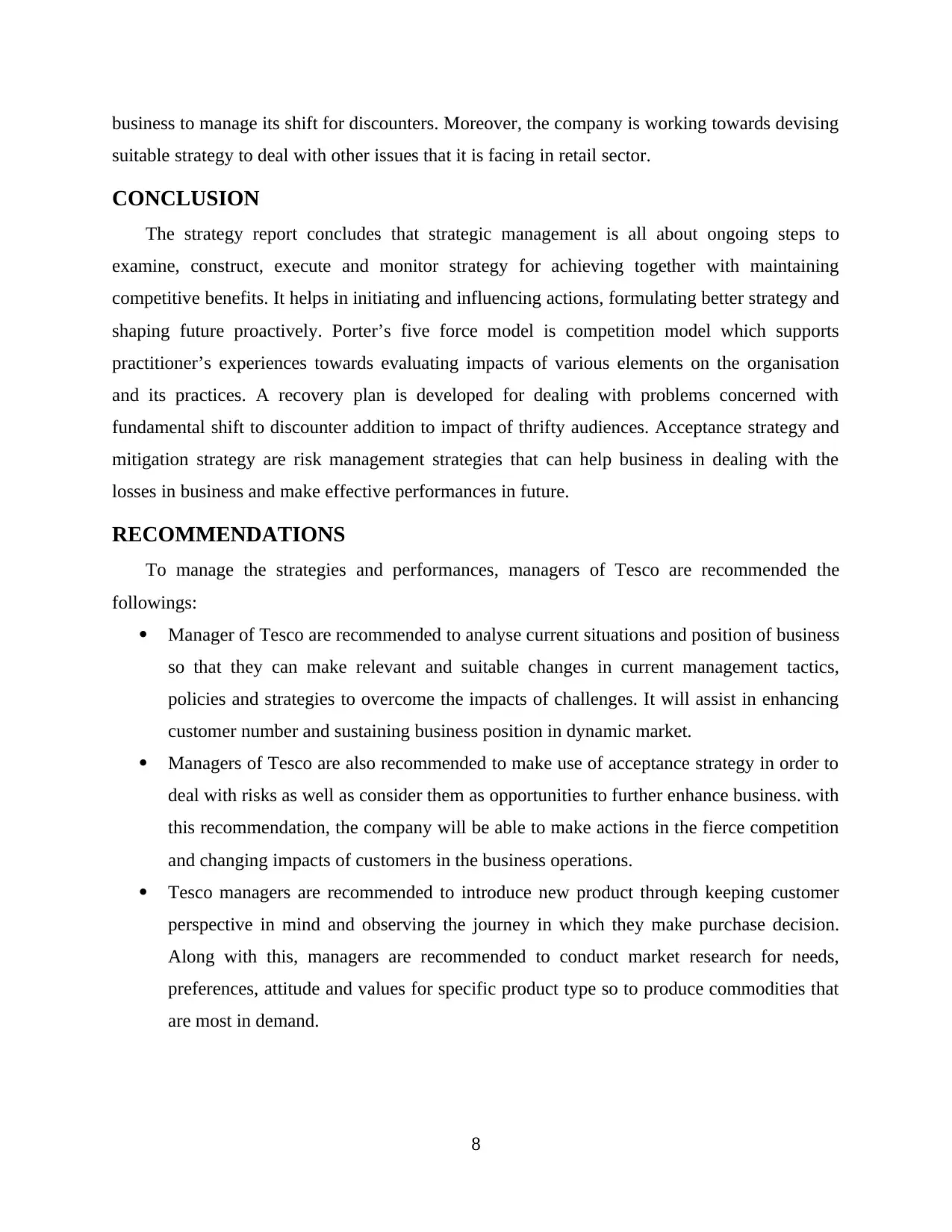
business to manage its shift for discounters. Moreover, the company is working towards devising
suitable strategy to deal with other issues that it is facing in retail sector.
CONCLUSION
The strategy report concludes that strategic management is all about ongoing steps to
examine, construct, execute and monitor strategy for achieving together with maintaining
competitive benefits. It helps in initiating and influencing actions, formulating better strategy and
shaping future proactively. Porter’s five force model is competition model which supports
practitioner’s experiences towards evaluating impacts of various elements on the organisation
and its practices. A recovery plan is developed for dealing with problems concerned with
fundamental shift to discounter addition to impact of thrifty audiences. Acceptance strategy and
mitigation strategy are risk management strategies that can help business in dealing with the
losses in business and make effective performances in future.
RECOMMENDATIONS
To manage the strategies and performances, managers of Tesco are recommended the
followings:
Manager of Tesco are recommended to analyse current situations and position of business
so that they can make relevant and suitable changes in current management tactics,
policies and strategies to overcome the impacts of challenges. It will assist in enhancing
customer number and sustaining business position in dynamic market.
Managers of Tesco are also recommended to make use of acceptance strategy in order to
deal with risks as well as consider them as opportunities to further enhance business. with
this recommendation, the company will be able to make actions in the fierce competition
and changing impacts of customers in the business operations.
Tesco managers are recommended to introduce new product through keeping customer
perspective in mind and observing the journey in which they make purchase decision.
Along with this, managers are recommended to conduct market research for needs,
preferences, attitude and values for specific product type so to produce commodities that
are most in demand.
8
suitable strategy to deal with other issues that it is facing in retail sector.
CONCLUSION
The strategy report concludes that strategic management is all about ongoing steps to
examine, construct, execute and monitor strategy for achieving together with maintaining
competitive benefits. It helps in initiating and influencing actions, formulating better strategy and
shaping future proactively. Porter’s five force model is competition model which supports
practitioner’s experiences towards evaluating impacts of various elements on the organisation
and its practices. A recovery plan is developed for dealing with problems concerned with
fundamental shift to discounter addition to impact of thrifty audiences. Acceptance strategy and
mitigation strategy are risk management strategies that can help business in dealing with the
losses in business and make effective performances in future.
RECOMMENDATIONS
To manage the strategies and performances, managers of Tesco are recommended the
followings:
Manager of Tesco are recommended to analyse current situations and position of business
so that they can make relevant and suitable changes in current management tactics,
policies and strategies to overcome the impacts of challenges. It will assist in enhancing
customer number and sustaining business position in dynamic market.
Managers of Tesco are also recommended to make use of acceptance strategy in order to
deal with risks as well as consider them as opportunities to further enhance business. with
this recommendation, the company will be able to make actions in the fierce competition
and changing impacts of customers in the business operations.
Tesco managers are recommended to introduce new product through keeping customer
perspective in mind and observing the journey in which they make purchase decision.
Along with this, managers are recommended to conduct market research for needs,
preferences, attitude and values for specific product type so to produce commodities that
are most in demand.
8
Paraphrase This Document
Need a fresh take? Get an instant paraphrase of this document with our AI Paraphraser
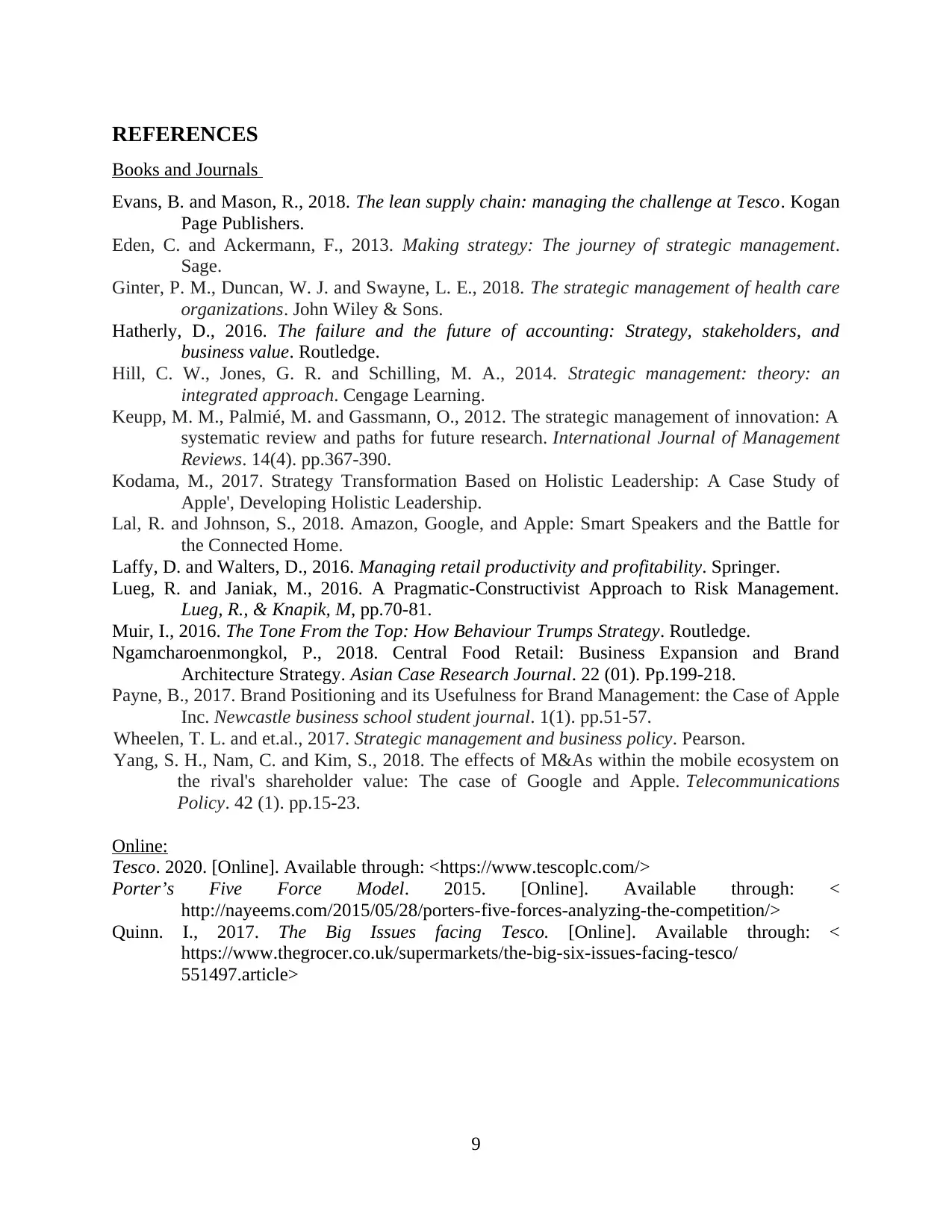
REFERENCES
Books and Journals
Evans, B. and Mason, R., 2018. The lean supply chain: managing the challenge at Tesco. Kogan
Page Publishers.
Eden, C. and Ackermann, F., 2013. Making strategy: The journey of strategic management.
Sage.
Ginter, P. M., Duncan, W. J. and Swayne, L. E., 2018. The strategic management of health care
organizations. John Wiley & Sons.
Hatherly, D., 2016. The failure and the future of accounting: Strategy, stakeholders, and
business value. Routledge.
Hill, C. W., Jones, G. R. and Schilling, M. A., 2014. Strategic management: theory: an
integrated approach. Cengage Learning.
Keupp, M. M., Palmié, M. and Gassmann, O., 2012. The strategic management of innovation: A
systematic review and paths for future research. International Journal of Management
Reviews. 14(4). pp.367-390.
Kodama, M., 2017. Strategy Transformation Based on Holistic Leadership: A Case Study of
Apple', Developing Holistic Leadership.
Lal, R. and Johnson, S., 2018. Amazon, Google, and Apple: Smart Speakers and the Battle for
the Connected Home.
Laffy, D. and Walters, D., 2016. Managing retail productivity and profitability. Springer.
Lueg, R. and Janiak, M., 2016. A Pragmatic-Constructivist Approach to Risk Management.
Lueg, R., & Knapik, M, pp.70-81.
Muir, I., 2016. The Tone From the Top: How Behaviour Trumps Strategy. Routledge.
Ngamcharoenmongkol, P., 2018. Central Food Retail: Business Expansion and Brand
Architecture Strategy. Asian Case Research Journal. 22 (01). Pp.199-218.
Payne, B., 2017. Brand Positioning and its Usefulness for Brand Management: the Case of Apple
Inc. Newcastle business school student journal. 1(1). pp.51-57.
Wheelen, T. L. and et.al., 2017. Strategic management and business policy. Pearson.
Yang, S. H., Nam, C. and Kim, S., 2018. The effects of M&As within the mobile ecosystem on
the rival's shareholder value: The case of Google and Apple. Telecommunications
Policy. 42 (1). pp.15-23.
Online:
Tesco. 2020. [Online]. Available through: <https://www.tescoplc.com/>
Porter’s Five Force Model. 2015. [Online]. Available through: <
http://nayeems.com/2015/05/28/porters-five-forces-analyzing-the-competition/>
Quinn. I., 2017. The Big Issues facing Tesco. [Online]. Available through: <
https://www.thegrocer.co.uk/supermarkets/the-big-six-issues-facing-tesco/
551497.article>
9
Books and Journals
Evans, B. and Mason, R., 2018. The lean supply chain: managing the challenge at Tesco. Kogan
Page Publishers.
Eden, C. and Ackermann, F., 2013. Making strategy: The journey of strategic management.
Sage.
Ginter, P. M., Duncan, W. J. and Swayne, L. E., 2018. The strategic management of health care
organizations. John Wiley & Sons.
Hatherly, D., 2016. The failure and the future of accounting: Strategy, stakeholders, and
business value. Routledge.
Hill, C. W., Jones, G. R. and Schilling, M. A., 2014. Strategic management: theory: an
integrated approach. Cengage Learning.
Keupp, M. M., Palmié, M. and Gassmann, O., 2012. The strategic management of innovation: A
systematic review and paths for future research. International Journal of Management
Reviews. 14(4). pp.367-390.
Kodama, M., 2017. Strategy Transformation Based on Holistic Leadership: A Case Study of
Apple', Developing Holistic Leadership.
Lal, R. and Johnson, S., 2018. Amazon, Google, and Apple: Smart Speakers and the Battle for
the Connected Home.
Laffy, D. and Walters, D., 2016. Managing retail productivity and profitability. Springer.
Lueg, R. and Janiak, M., 2016. A Pragmatic-Constructivist Approach to Risk Management.
Lueg, R., & Knapik, M, pp.70-81.
Muir, I., 2016. The Tone From the Top: How Behaviour Trumps Strategy. Routledge.
Ngamcharoenmongkol, P., 2018. Central Food Retail: Business Expansion and Brand
Architecture Strategy. Asian Case Research Journal. 22 (01). Pp.199-218.
Payne, B., 2017. Brand Positioning and its Usefulness for Brand Management: the Case of Apple
Inc. Newcastle business school student journal. 1(1). pp.51-57.
Wheelen, T. L. and et.al., 2017. Strategic management and business policy. Pearson.
Yang, S. H., Nam, C. and Kim, S., 2018. The effects of M&As within the mobile ecosystem on
the rival's shareholder value: The case of Google and Apple. Telecommunications
Policy. 42 (1). pp.15-23.
Online:
Tesco. 2020. [Online]. Available through: <https://www.tescoplc.com/>
Porter’s Five Force Model. 2015. [Online]. Available through: <
http://nayeems.com/2015/05/28/porters-five-forces-analyzing-the-competition/>
Quinn. I., 2017. The Big Issues facing Tesco. [Online]. Available through: <
https://www.thegrocer.co.uk/supermarkets/the-big-six-issues-facing-tesco/
551497.article>
9
1 out of 11
Related Documents
Your All-in-One AI-Powered Toolkit for Academic Success.
+13062052269
info@desklib.com
Available 24*7 on WhatsApp / Email
![[object Object]](/_next/static/media/star-bottom.7253800d.svg)
Unlock your academic potential
Copyright © 2020–2025 A2Z Services. All Rights Reserved. Developed and managed by ZUCOL.




